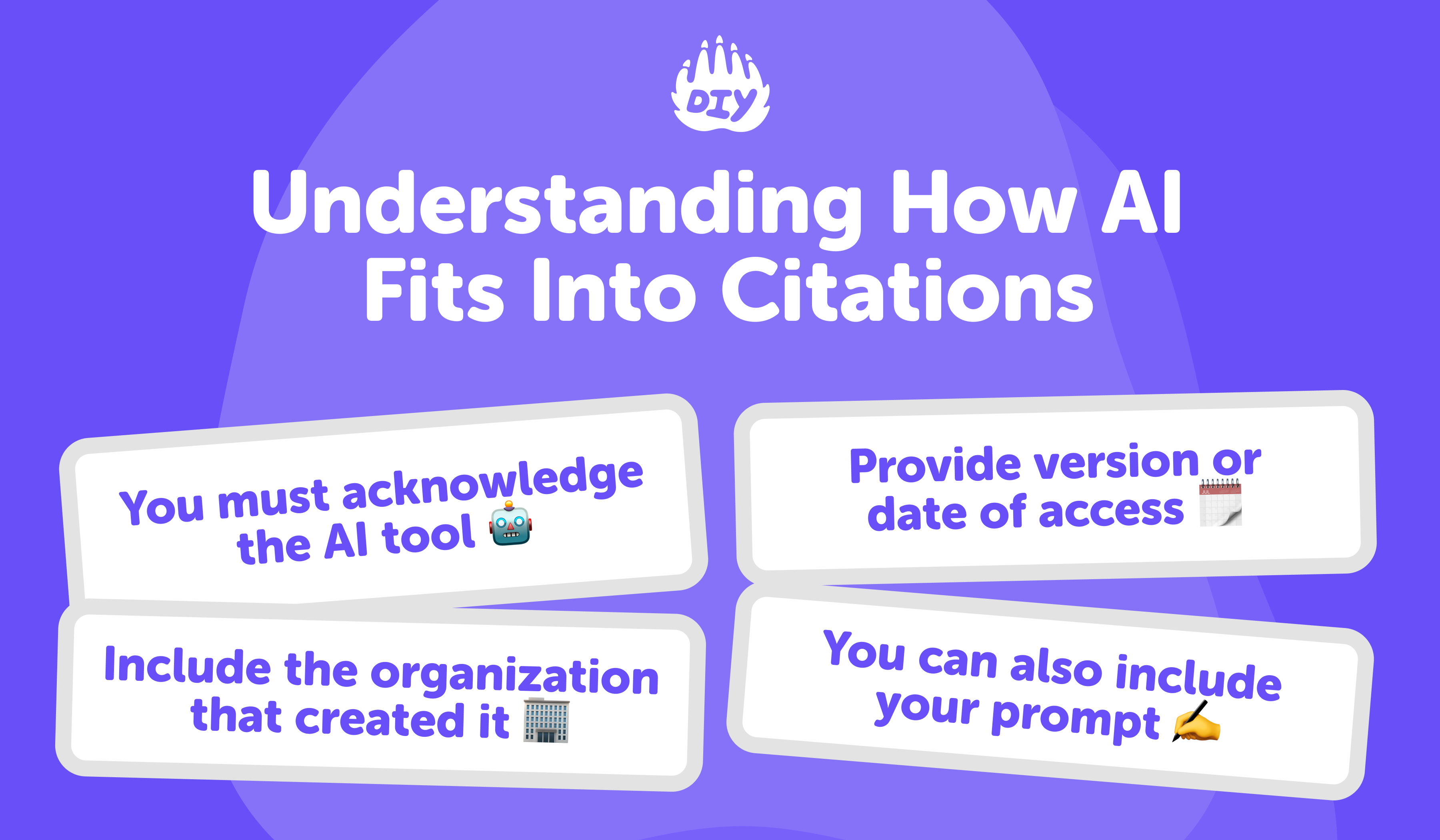With tools like ChatGPT, Google Gemini, and Claude becoming part of everyday writing, students and professionals alike are asking one big question: “How do I cite AI in MLA or APA?”
Citing AI properly isn’t just about following rules, it's about maintaining academic honesty and research transparency. When you use AI to summarize text, brainstorm ideas, or check grammar, you’re drawing from a source. Even though it’s not a person or a book, the AI still generated original text that should be credited.
By the end of this guide, you’ll know exactly how to cite AI tools in both MLA and APA styles the easy way with real examples you can copy and adapt for your assignments.
Need step-by-step help citing sources (without shortcuts)? Try the kid-safe AI Homework Helper.
Understanding How AI Fits Into Citations
AI chatbots don’t have human authors, so they don’t fit neatly into traditional citation formats. They aren’t books, websites, or articles. They’re tools and that’s exactly how citation styles like MLA and APA recommend treating them.
Both the Modern Language Association (MLA) and the American Psychological Association (APA) have issued updated guidance for AI-generated content. In short:
You must acknowledge the AI tool (e.g., ChatGPT, Gemini).
Include the organization that created it (e.g., OpenAI, Google).
Provide version or date of access, since AI outputs evolve quickly.
You can also include your prompt, especially in MLA format, for transparency.
How to Cite AI in MLA Format
If you’re writing a paper for the humanities, English, or literature, MLA is your go-to style. It’s all about clarity and traceability and yes, you can absolutely cite ChatGPT or any AI tool.
Step-by-Step MLA AI Citation
Start with the tool name: ChatGPT, Gemini, or Claude.
Add the creator: OpenAI, Google, or Anthropic.
Include the prompt (optional but recommended).
Add the date you accessed the AI tool.
Provide the URL (chat.openai.com, gemini.google.com, etc.).

MLA Citation Example
ChatGPT. “Explain how volcanoes form.” OpenAI, 2025, https://chat.openai.com/. Accessed 1 Oct. 2025.
MLA In-Text Citation
(ChatGPT) If you mention a specific response from AI, include a short description in your sentence e.g., Generated using ChatGPT (OpenAI, 2025). This helps your reader understand where the content came from.
AI help that teaches, not replaces. Get hints, examples, and practice prompts all with guardrails for kids.
How to Cite AI in APA Format
APA format is widely used in psychology, business, and social sciences. In this style, the AI tool is considered a nonrecoverable source meaning others can’t reproduce your exact conversation. That’s why APA focuses on who made the tool and when it was accessed.
Step-by-Step APA AI Citation
Author: The organization behind the tool (e.g., OpenAI).
Date: Year or version date of the AI output.
Title: The name of the tool and version in italics.
Description: Identify it as an AI or “Large language model.”
URL: Include the tool’s main access link.
APA Citation Example
OpenAI. (2025). ChatGPT (Oct 1 version) [Large language model]. https://chat.openai.com/
APA In-Text Citation
(OpenAI, 2025)
If your paper analyzes AI text, explain the prompt and output context in your methodology rather than trying to fit it into a standard reference list. That keeps your paper accurate and professional.
MLA vs APA: What’s the Difference?
Although both styles recognize AI tools as sources, they differ in formatting and emphasis:
Feature | MLA | APA |
Author | AI Tool (e.g., ChatGPT) | Organization (e.g., OpenAI) |
Date Format | “Accessed” date | Publication or version year |
Prompt Included | Optional | Usually excluded |
URL | Required | Optional if version listed |
Used In | Humanities | Social Sciences |
Quick Summary
Use MLA when your paper focuses on language, literature, or cultural studies.
Use APA for research-based, data-driven, or scientific papers.
Tools to Generate AI Citations Automatically
If formatting feels tedious, try these AI citation generators that handle MLA and APA automatically:
Scribbr AI Citation Generator – Updates frequently with style changes.
MyBib.com – Fast and includes both MLA and APA templates.
ZoteroBib – Perfect for managing multiple AI references at once.
⚠️ Always double-check the output! Citation tools may skip version numbers or access dates, which are crucial for AI sources.
Common Mistakes When Citing AI
Even with examples, it’s easy to make small errors that can affect your paper’s credibility. Here are a few common pitfalls to avoid:
❌ Forgetting the access date (MLA) or version year (APA).
❌ Listing the AI as a human author. Always use the organization or tool name.
❌ Skipping the description. APA requires identifying the source as a large language model.
❌ Using outdated citations. MLA and APA updated their AI citation rules in 2024–2025.
Always consult the official style guides or your school’s writing center for the latest updates.
Examples on When and How to Cite AI
Here are a few real-world situations where citing AI tools like ChatGPT makes sense:
1. Brainstorming Help
If ChatGPT suggested essay topics or structure ideas, acknowledge it in your methodology:
“This outline was developed with support from ChatGPT (OpenAI, 2025).”
2. Summarizing a Concept
When you directly use AI-generated explanations:
ChatGPT. “Summarize the main causes of the French Revolution.” OpenAI, 2025. Accessed 1 Oct. 2025.
3. Research Assistance
If you used AI for finding sources or quotes:
“The AI model provided preliminary search terms but did not generate final text.”
In every case, clarity is key; readers should always know what part of your work AI assisted with
Make homework calmer (and learning stick). DIY’s AI Homework Helper guides math, reading, and writing with safe prompts and built-in study habits.
Quick Reference Table
Citation Style | Example | Best For |
MLA | ChatGPT. “Prompt.” OpenAI, 2025, URL. Accessed 1 Oct. 2025. | Essays, Humanities |
APA | OpenAI. (2025). ChatGPT (Oct 1 version) [Large language model]. URL | Research, Reports |
AI Acknowledgment & Citation FAQs
What do I need to acknowledge an AI tool?
Name the tool (e.g., ChatGPT/Gemini), the creator (OpenAI/Google), and the version or access date.
How do I cite AI in MLA, briefly?
ChatGPT. “Your exact prompt.” OpenAI, https://chat.openai.com/. Accessed 1 Oct. 2025.
How do I cite AI in APA, briefly?
OpenAI. (2025). ChatGPT (Oct 1 version) [Large language model]. https://chat.openai.com/
Should I list the AI as an author?
No. Credit the organization (APA) or the tool (MLA), not the AI as a person.
Where do I put my prompt?
Add it as an MLA-style note or an appendix for transparency.
The Future of AI Citations
As AI tools evolve, so will citation formats. Universities and style guides continue to update standards for the ethical use of AI, so staying informed is essential. Soon, we may see new citation styles built entirely around AI tools, making references even more transparent.
Bookmark this guide, as citation rules for AI are still evolving, and small updates occur every year.
Cite Smart, Stay Transparent
Whether you’re using ChatGPT, Gemini, or another AI assistant, the rule is simple: If AI helped you create it, cite it. Giving credit protects your integrity, makes your work more trustworthy, and aligns with academic honesty standards.
By following these examples, you’ll never have to guess how to cite AI in MLA or APA again. Remember: transparency is the real mark of a confident, credible writer.




